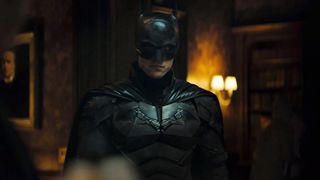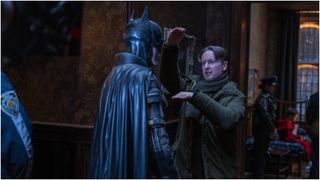The Batman director Matt Reeves details the deleted scene starring *that* cameo character
We caught up with The Batman's director to talk about his plans for that surprise character

The Batman has arrived in cinemas – and there are plenty of surprises in The Dark Knight's latest on-screen appearance. Robert Pattinson's debut introduces various new incarnations of famous villains, including Penguin and Riddler, but few people expected a certain someone to appear...
Warning! Spoilers for The Batman ahead. Turn back now if you have not seen the new movie in cinemas.
Now that the spoiler warning's out of the way, let's stop talking in riddles: one of the movie's final scenes see The Riddler meet a mysterious character who's also locked away in Arkham. Played by Barry Keoghan, the inmate may not be named in the credits, but anyone with a working knowledge of Batman will know that he's the man who will one day become the Joker.
Total Film sat down with director Matt Reeves to discuss the scene and the character, the filmmaker revealing lots of new details, including how this version of the Joker is influenced by the Elephant Man, as well as Conrad Veidt's The Man Who Laughs, who inspired the original comic-book look of Joker. Here's what Reeves had to say, his lengthy answer edited for length and clarity.

Reeves: "The scene with Barry is actually one of two scenes that we shot. The first scene one that's not in the film, we will definitely release, it's a really cool scene. It was just one of those things where, in the course of the movie, what that scene was doing, other scenes were also doing, and so we didn't need the scene. But as a standalone, that scene is very eerie and creepy and cool.
"In the movie, the Riddler is leaving these messages for Batman and it's very unnerving for him. Batman decides that he needs to – almost like the movie Manhunter – profile the killer. And so he goes to Arkham and meets up with another killer, who he's obviously had some experience within Year One. He probably had something to do with putting him there.
"Barry says, 'It's almost our anniversary, isn't it?' And you're like, 'Who is this guy?' And that's why he's called the 'Unseen Prisoner' in the movie. You're getting into this psychological horror, he's getting into the mind of Batman and Batman is trying to understand, 'Why do you think this guy's writing to me?' And he says, "What do you mean, the two of you are the same." He's getting into Batman's mind. Barry and Rob, they did the scene so beautifully.
Sign up for the Total Film Newsletter
Bringing all the latest movie news, features, and reviews to your inbox
"Because the rogues' gallery characters are in their origins, I thought, here's a way to do the Joker before he's ever the Joker. In our version, he has this contact with Batman, before he becomes the Joker, before he takes on that moniker. But you can see all of the seeds of the Joker already there.
"I worked on it with Mike Marino, who did the makeup, he also did [Penguin actor] Collin [Farrell]'s makeup. He's a genius. We did some stuff that was really based on Conrad Veidt and The Man Who Laughs. I started thinking, if we're going to do another iteration of the Joker, I don't want to do what [Christopher] Nolan had done with the scars. And then, of course, there's Jack Nicholson and the idea of the chemicals. There are lots of classic versions.
"To me, what was interesting was doing the Elephant Man. The Conrad Veidt idea was that he had some kind of congenital disease, and he couldn't ever stop smiling. Well, what if Joker has some kind of disease from birth where he's marked by this horrific smile, and the world treated him in a certain way that created him. We had this nihilistic point of view that came with the fact that fate had played a joke on him since birth. Whereas the Elephant Man had this beautiful soul inside, Joker was turned into this gothic horror figure.
"All of that was going to be done out of focus. So when you see the scene, you'll see that we sketched in, what Mike sketched in the Joker, but in a way where he had to do that out of focus. And then this final scene was meant to be a callback. I thought, 'Wouldn't that be interesting to finish the Riddler arc and have, right next to him, the Joker, and have the beginning of this relationship?'
"It was never meant to say, 'That means it's the next movie.' That isn't what we're doing. At the end of the movie, when Selena says, 'You know, this place is never going to change,' you need to understand that something is already brewing. Seeing those two characters in Arkham is making you feel like 'Oh, boy, trouble is coming.' That was why we kept the scene, not to say like, 'Here's an Easter egg and now this is the next movie.' It's not necessarily the next movie. It's this idea that the Gotham that we've been building, and you've been seeing, it's the beginning of the rogues' gallery of characters coming into being. This is another part of the texture for fans who love these characters.
"Barry's very unnerving. He's a wonderful actor. And he was really brave. When I started writing this movie, [Joaquin Phoenix's] Joker hadn't come out. I didn't even know that they were making Joker when I started. Joaquin gives an incredible performance. And when we started making this movie, Joaquin had just won the Academy Award. And so, for Barry to jump into this, we were saying, 'Look, we honestly don't know where this character goes, but you'll be jumping into this thing that a high wire act.' And he was very brave. He was like, 'I'm ready, man. I'll jump in.' He was great."
For more – much more – on The Batman, check out our guides to:
- The Batman ending explained
- The Batman Easter eggs and references
- The Batman secret message you missed
- Was Joaquin Phoenix's Joker meant to be in The Batman?
- When is The Batman on HBO Max?
- Who plays Joker in The Batman?
- The best Batman movies, ranked!
- How to watch the DC movies in order
In a DC mood? Look ahead to the new superhero movies coming your way in 2022 and beyond.

Jack Shepherd is the former Senior Entertainment Editor of GamesRadar. Jack used to work at The Independent as a general culture writer before specializing in TV and film for the likes of GR+, Total Film, SFX, and others. You can now find Jack working as a freelance journalist and editor.
Most Popular



